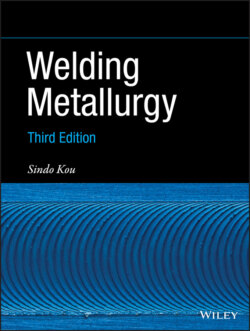Читать книгу Welding Metallurgy - Sindo Kou - Страница 24
1.3.1.1 Functions of Electrode Covering
ОглавлениеThe covering of the electrode contains various chemicals and even metal powder in order to perform one or more of the functions described below:
Protection. The electrode covering provides a gaseous shield to protect the molten metal from air. For a cellulose‐type electrode, the covering contains cellulose, (C6H10O5)x. A large volume of gas mixture of H2, CO, H2O, and CO2 is produced when cellulose in the electrode covering is heated to decompose. For a limestone‐ (CaCO3‐) type electrode, on the other hand, CO2 gas and CaO slag form when the limestone decomposes. The limestone‐type electrode is a low‐hydrogen‐type electrode because it produces a gaseous shield low in hydrogen. It is often used for welding metals that are susceptible to hydrogen cracking, such as high‐strength steels.
Deoxidation. The electrode covering provides deoxidizers and fluxing agents to deoxidize and cleanse the weld metal. The solid slag formed also protects the already solidified but still hot weld metal from oxidation.
Arc stabilization. The electrode covering provides arc stabilizers to help maintain a stable arc. The arc is an ionic gas (a plasma) that conducts the electric current. Arc stabilizers are compounds that decompose readily into ions in the arc, such as potassium oxalate and lithium carbonate. The potassium and lithium ions increase the electrical conductivity of the arc and help the arc conduct the electric current more smoothly.
Metal addition. The electrode covering provides alloying elements and/or metal powder to the weld pool. The former helps control the composition of the weld metal while the latter helps increase the deposition rate.
